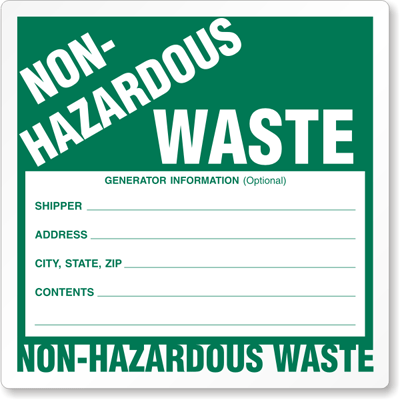
Continuing our series of things you think you know about hazardous waste, this week Heritage Compliance Manager Mike Karpinski wrote about another common hazardous waste misconception. The idea that all non-hazardous wastes are “safe.”
This is the opposite side of last weeks post about all hazardous wastes being dangerous. As far as safety is concerned, it is even more important that people working with wastes understand that just seeing a “Non-Hazardous” or “Non-Regulated” sticker on a container does not mean it is not a dangerous material or is not subject to other regulatory programs.
These lables are simply regulatory classifications that guide the management of such materials. Often times, a material labeled “non-hazardous” can present an equal health or physical hazard to persons working with it as something marked hazardous (remember the story about the swimming pool from last week). Physical and chemical hazards associated with materials have thresholds established by the regulations for classification of waste.
For example, a liquid is considered hazardous waste when it has a flash point less than 140 degrees Fahrenheit by a specified testing protocol. A flashpoint is the temperature at which a particular organic compound gives off sufficient vapor to ignite in the air. Using the flashpoint criteria, gasoline would be a hazardous waste based on flash point, but used motor oil typically would not. That being said, we must note that both of these materials should be handled with care not only from an environmental perspective but from a fire hazard perspective.
More News From Heritage
-
3/6/25
Accelerating Action: Celebrating International Women’s Day
Learn about how we're celebrating International Women's Day
-
2/21/25
Heritage Announces East Liverpool, Ohio 2025 Environmental Grant Program
Learn about our East Liverpool Ohio grant opportunity!
-
2/18/25
Heritage Environmental Services Announces James (Shelby) Marlow as Chief Financial Officer
Heritage Environmental Services announced today that James (Shelby) Marlow will join the organization as Chief Financial Officer.
-
1/31/25
January Community Engagement Initiative: Home/Work Energy Reduction
Learn about our January community engagement initiative
-
1/29/25
Heritage Environmental Services Announces Chris Ebeling as Chief Commercial Officer
Heritage Environmental Services announced today that Chris Ebeling will join the organization as Chief Commercial Officer.
-
1/28/25
Heritage Environmental Services Addresses Industry Challenges with New State-of-the-Art Shredder
Heritage Environmental Services announced a new state-of-the-art shredding unit.
-
1/7/25
Navigating e-Manifest: What You Need to Know About Hazardous Waste Compliance
Learn about the e-Manifest Third Rule changes that begin January 22, 2025
-
12/23/24
Wreaths Across America 2024
This year, through collective effort and heartfelt generosity, we sponsored 727 wreaths and transported two truckloads of wreaths across the country.








